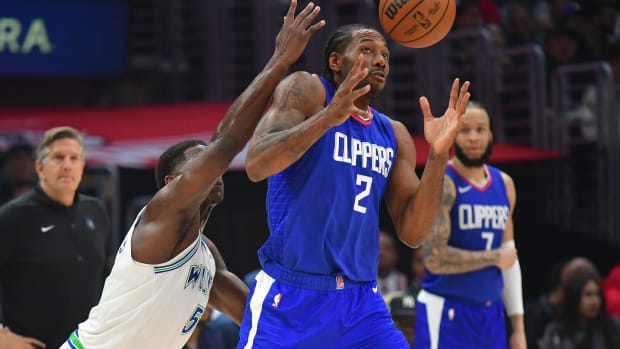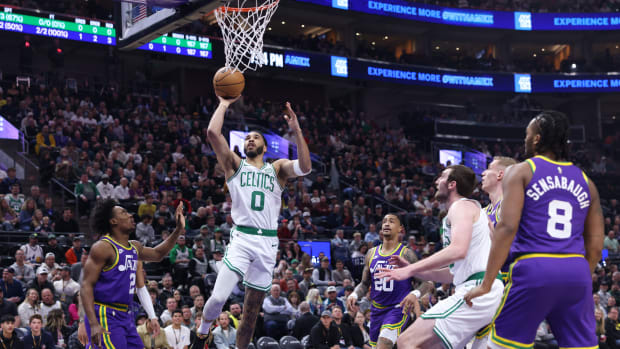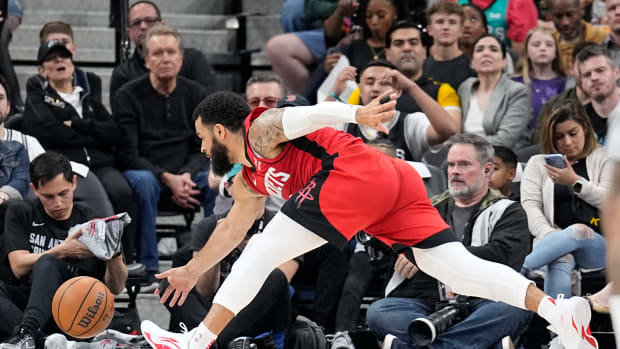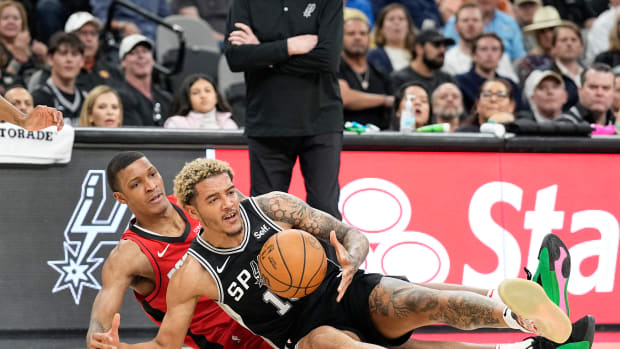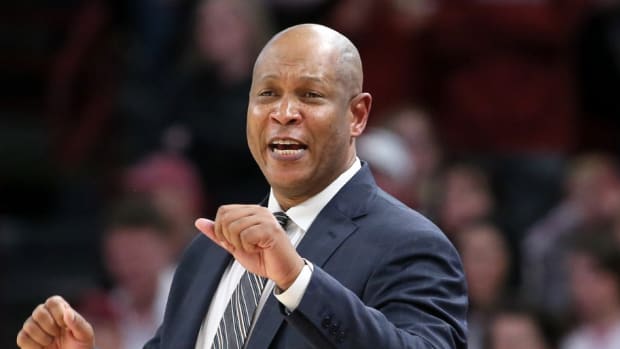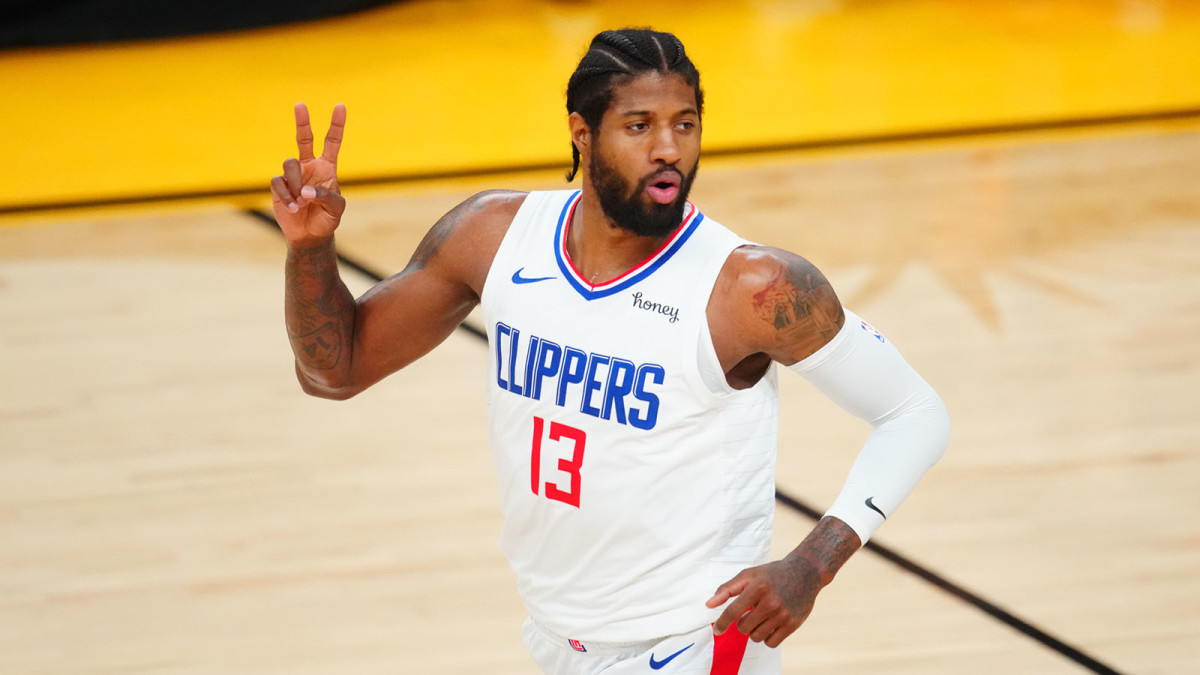
West Champs? Don’t Count Out the Clippers
Last December, the Clippers were both a contender and a cautionary tale. Their collapse against the Nuggets at the end of the 2019-20 season, after holding a 3-1 lead as heavy favorites, was a humbling fork in the road for just about everyone involved.
Despite signing Kawhi Leonard, then trading just about every valuable asset they had for Paul George (one season after he finished third in the MVP race) and complementing the two stars with a potent bench mob—including Montrezl Harrell, who had just won Sixth Man of the Year—the organization’s blood type remained “laughingstock.” After that season, fingers were pointed. Reputations were dyed beneath an unflattering light. Chemistry was vapor. George was heavily criticized as a valid No. 2 option. Doc Rivers was fired.
Then last season—their most successful in 51 years of existence—happened. The Clippers finished second in net rating and third all-time in True Shooting percentage, on their way to exorcising quite a few demons and establishing the exact sort of internal trust and confidence they carry with them to this day. The vibes, finally, are good. Even though they didn’t win it all, they showed they can, battling back from an 0-2 deficit in Round 1 to snuff out Luka Dončić's surreal postseason coming out party, with three gutsy road wins that included Leonard’s 45-point masterpiece in Game 6.
In Round 2 against a first-place Jazz squad that had just spent the regular season obliterating everything in their path by a historic margin, the Clippers won four straight after falling into another 0-2 hole and watching Leonard’s knee buckle toward the end of Game 4. The series ended with an explosive 81-47 second-half beatdown in Game 6.
Without Leonard and Serge Ibaka (a symbolic dividing line from 2020 to 2021), and with an extremely dour crunchtime offense, the Clippers played with belief behind some of the most inspiring basketball of George’s career and Reggie Jackson’s volcanic redefinition of a heat check. Ty Lue mixed and matched lineups with the league’s most versatile roster, navigating injuries suffered by Marcus Morris, Ibaka and Ivica Zubac as best he could, with an experienced group that welcomed the scrappy underdog persona. (The Clippers deployed a whopping seven starting lineups in the playoffs; 12 of their 19 games began with no center on the floor. They eventually ran out of gas against the Suns, losing Games 2 and 4 by a combined five points.)
Now, even with Leonard recovering from a partially-torn ACL that could sideline him anywhere between four months or opening night of the 2022-23 season (nobody knows!), the Clippers might be as dangerous as they’ve ever been. Even if the championship-or-bust assumption they’ve carried over the past two years no longer remains, the doubt that clouded most of their 2020-21 season has disappeared. Which creates one of this season’s biggest questions: How good are the Clippers, really? There’s zero chance they can win it all without Leonard, which Lue conceded last month may be their reality. “We want to make sure he’s rehabbing and doing everything he can to get back as soon as possible,” he told reporters. “If that’s next season, it’s next season.”
But the door is open for an earlier appearance, too. Speaking about his contract at Clippers media day, the two-time Finals MVP divulged his rationale for signing a new four-year deal as opposed to a one-plus-one, which is the route he should’ve gone if attempting to maximize his earnings. He wanted to play. “I wanted to secure some money, and I wanted to come back if I was able to this year. If I had took the 1-plus-1, I probably would have not played just to be cautious and then opted out into the five-year.”
That possibility, which is enough for 538’s NBA forecast to give the Clippers a higher title-winning probability than every team except the Bucks, is almost by itself enough reason to believe this team can go farther than it did last season. And beyond Leonard’s injury, the Clippers should still be able to chug along with the steady progression of a team that truly believes they’re better than every other, even while knowing they have a much higher gear with their best player in the lineup.
All optimism starts with George, who returned to his All-NBA form last year and enters his 12th season as his team’s No. 1 option for the first time since he left the Pacers. He’s 31 without any real offensive weaknesses. He can make every advanced read there is running a pick-and-roll—he sees the corner skips and lobs while knowing a pull-up jumper or rack attack is always available—or turning the corner on a dribble handoff.
Even without Leonard, the Clippers should still have enough ball handlers who can utilize George’s excellent off-ball movement, running him off screens and letting him space the floor as a terrific spot-up threat. His effective field goal percentage on catch-and-shoot tries was a whopping 63.7% last season, and there will be lineups where his gravity is best served amplifying everybody else instead of it needing to be the other way around.
The Clippers’ offense was league average when George took the floor without Leonard and knocked on the door of the top 10 when both All-Stars didn’t play. It’s hard to know how relevant those numbers are in relation to a brand new season, alongside several teammates who share the experience of last year’s playoff run and will prepare each night knowing Leonard isn’t around. The game plans, roles, lineups, minutes and touches won’t be the same for anyone. With a team as deep as this one, that probably won’t be a bad thing.
Someone like Luke Kennard, who was an afterthought for most of last season, can step up as a secondary playmaker deserving of a few more sets that are designed with his outside shot in mind. There are spots (though not too many) where Marcus Morris can single-handedly ease the burden with his self-starter shot-making. There’s little chance he makes 47.3% of his threes again—he did shoot 43.9% in his previous stop with the Knicks, however, so it’s not like people will be leaving him open—but in the right matchup Morris can draw two defenders and open up easier scoring avenues against a scrambling defense.
Elsewhere, George is surrounded by several key vets who could’ve left in free agency but chose not to. Jackson, Nicolas Batum and Ibaka (who’s still recovering from offseason back surgery but is participating in 5-on-5 drills at practice) are a warm blanket. There’s little confusion when they’re on the floor and off it they’ll maintain a comfort level, pecking order and degree of professionalism that can push L.A. through another 82-game slate.
There are important changes, though. Gone is Patrick Beverley, a dedicated irritant whose stellar on-ball defense against Devin Booker in the conference finals should be taught by coaches for the next 100 years. He’ll be missed, especially as a knockdown shooter who can augment L.A.’s offense without the ball in his hands. Rajon Rondo (once again) plays for the Lakers.
In their place comes Eric Bledsoe and Justise Winslow, two quality defenders whose place on offense is a bit less clear thanks to the questionable/nonexistent outside shooting they’re able to provide. Despite poor preseasons from them both, that doesn’t make them zeroes. Bledsoe is expected to start alongside Jackson, George, Morris and Zubac, which could be perfectly fine against most teams, beside three marksmen and a dive partner. As a playmaker, Bledsoe is still decent, and should look much better on a roster that doesn’t have at least two non-shooters on the floor at all times.
Only 21% of his shots came at the rim last season. That’s half what it was the previous year, and his previous career low was 32% back in 2017. He can still finish when he gets there, and Synergy Sports ranked him in the 93rd percentile during pass out situations from a pick-and-roll. In small lineups (and when Ibaka returns) Bledsoe should be able to orchestrate action as the point guard presence Los Angeles hasn’t had the past couple seasons. It won’t be as easy generating quality three-point looks without Leonard drawing everyone’s attention, but this will help:
Of course, the shortcomings can’t be ignored. According to Synergy Sports, Bledsoe made only 33.3% of his unguarded jump shots in the halfcourt last season. He finished at 34.1% from behind the arc, which could be worse for regular season play but, in big minutes, would sabotage elements of the Clippers’ offense in a competitive playoff series—even with Leonard all the way back.
Much of this applies to Winslow, who pretty much shouldn’t ever be on the floor with Bledsoe but has the size and vision to commandeer second units as a pseudo point guard uplifted by wider driving lanes than he had with the Grizzlies or Heat. There’s more athleticism, upside and positionless virtue here, too, when he’s healthy—which he hasn’t been in quite some time.
And then there’s Terance Mann, who recently signed his own contract extension. It’s a crime to go this long before mentioning the 25-year-old, but his recent emergence changes everything from where Los Angeles was when it first became a contender to where it stands today. Mann came of age as Lue’s “break-in-case-of-emergency” spark for most of last season until Leonard went down against the Jazz, when his energy became paramount to L.A.’s success. From there, whether off the bench or in the starting lineup, he shined.
As another two-way presence who can do a little bit of everything, Mann allows the Clippers to play like-sized, switch-everything lineups without sacrificing too much on either end. George, Mann, Winslow, Batum and Morris is a mismatch waiting to happen. But Mann also gives Lue the option of an all-bench unit when everybody is available to play: Mann, Batum, Ibaka, Winslow and Kennard could hold their own against most starting fives, let alone opposing bench units. (And they can play fast, something these Clippers will probably have to do more of without Leonard around to simplify half-court offense.)
Mann personifies their roster-wide adaptability, with a coach who’s unafraid of experimentation. To boot, these Clippers have plenty of shooting, playmaking, rim protection, length and selflessness. There are young talents who’ve yet to emerge and several layers of experience at every position.
Watch NBA games online all season long with fuboTV: Start with a 7-day free trial!
Without Leonard they have enough talent to make the playoffs outright, above the play-in tournament in a conference that’s slippery up top. As they integrate new pieces and accept new roles, the Clippers are still built to withstand another injury or two and rank in the top 10 on both sides of the ball.
If they coalesce without their best player, as they're constructed to do, the thought of potentially adding Leonard in March or April should terrify every other team in the league. Even with 80-90% of Leonard’s peak self, the Clippers would be recognized as a bonafide contender, if not the clear favorite to emerge from the Western Conference. Over the past two years, all the Clippers have done is the exact opposite of what everybody expected. Why should this season be any different?
More NBA Coverage:
• Be Patient With the Lakers
• Is This the End of NBA Dynasties?
• Seven Breakout Candidates for the 2021–22 NBA Season
• NBA Entertaining Rankings: Most Exciting Teams to Watch
Sports Illustrated may receive compensation for some links to products and services on this website.






























